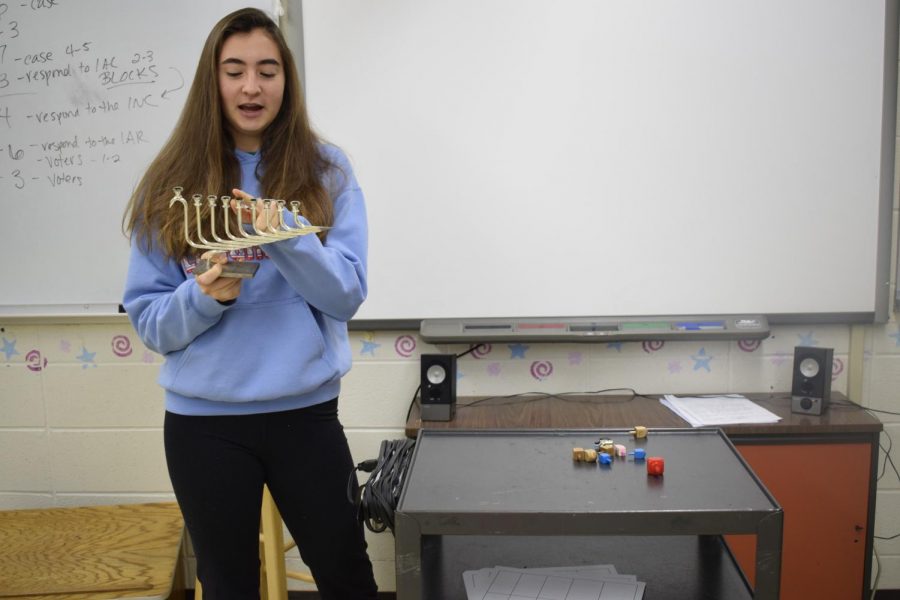Placing Challah and a Shofar on a table in front of them, juniors Joe Rosenberg, Ella Seigel and Sara Marks stand in front of a classroom of strangers waiting for their presentation to begin. The three¬Ý participate in Student to Student, a program in which Jewish high schoolers around St. Louis present about their faith at a variety of high schools.
“I know that there are not a lot of Jews around the St. Louis area and around the United States in general, so I think it is important to be able to educate people about the Jewish religion and get rid of some of the common misconceptions,” Rosenberg said.
Members of Student to Student are split¬Ý into groups of three or four with representation from each branch of Judaism: Orthodox, Conservative and Reform.
‚ÄúI have to be understanding and willing to explain when someone has a misconception about me or my religion. It shows that there’s not just one type of Jew,‚Äù Rosenberg said.¬Ý ‚ÄúOne common misconception is that all Jews are Orthodox, that they all have the black hats and the black suits and payot, the curly hair on the side of their head.‚Äù
Rosenberg believes it is important for others to realize that he can be Jewish but still look like a typical American teenager.
“There are also people who do look more stereotypically Jewish. I do not fit into a lot of Jewish stereotypes, and that does not make me any less of a Jew,” Rosenberg said.
This was Rosenberg, Marks and Seigel first opportunity to present components of their faith, such as holidays, the Sabbath, Jewish life, the Holocaust and Israel.
‚ÄúThey really cared. You could see that they were interested and engaged in the topic areas. They asked questions, so they learned things they didn’t previously know,‚Äù Seigel said.
Presentations take place during the school day at schools around the area with limited Jewish populations.
‚ÄúI hope that they rethink Judaism, not just label it, and maybe gain some similarities between them in their religion. We may not believe the same things or do all the same things, but we’re also people, and they find a bit more middle ground,‚Äù Marks said.
The Student to Student program was created with the goal of combating hatred and ignorance towards the Jewish community.
‚ÄúMisconceptions and stereotypes about religion breed hate and every single person in Student to Student has a story where they’ve experienced anti-Semitism or small aggressions against them,‚Äù Seigel said. ‚ÄúOne of my friends has a teacher who outwardly showed anti-Semitism, which drove him away from public school. It’s becoming more of a normalized part of our society. A lot of people’s stories had to do with really close friends‚Äìpeople who felt comfortable enough to say things that were hurtful and insensitive. That’s one of the reasons Student to Student is really important right now.‚Äù¬Ý
Rosenberg has experienced offensive speech and micro-aggressions like jokes made about Jews and the Holocaust.
‚ÄúA lot of times people don’t realize that I’m Jewish and that it might actually offend me,‚Äù Rosenberg said. ‚ÄúI don‚Äôt care too much when I know they weren‚Äôt trying to be mean. If they were intentionally being anti-Semitic, I don‚Äôt take it lightly. There are some select individuals who have made it clear that they do not like Jews, and they’re very comfortable saying that to me even though they know that I’m a Jew.‚Äù
If students take away one extra piece of information, the objective of the Student to Student presentation has been reached.¬Ý
“I feel like I had an enlightening impact. [The students] heard about Jews in the past, but they’ve never really met one. Sometimes, I feel as if I am talking to a stack of bricks. If they actually put forth the effort to better themselves and learn about my faith, I feel as if I have accomplished something,” Rosenberg said.¬Ý



![Gazing up from the stage, junior Joseph McCurdy who played Peter Pan in the school play, Lost Girl, sits next to senior Juliana Rogers, who plays Wendy Darling, during a theater rehearsal. McCurdy’s passion for theater began when he observed a West High production in middle school. “I've been in the high school theater program since I was a freshman. I've always loved theater, but [what prompted me to join] was [when] I went to see [a performance here] when I was in middle school, and it was super cool,” McCurdy said.](https://pwestpathfinder.com/wp-content/uploads/2025/11/IMG_6535-1200x798.jpeg)

![Standing tall, stacked in a precise formation, the cheer team strikes a signature pose during halftime on Sept. 12 at the varsity football game. Nearly a month after this performance, the cheer team performed at the Missouri Cheerleading Coaches Association (MCCA) regional competition on Oct. 4, 2025. “We've all come [to] work together a lot more,” sophomore Elyssa Philippi said. “We're a lot closer than we were [earlier in the season] and going to state has made us closer [in] trying to work with each other, learn [new] skills and make our team better.”](https://pwestpathfinder.com/wp-content/uploads/2025/11/DSC5139-1.jpg)
![Handing out candy to excited trunk-or-treaters, President of the United Nations Children’s Fund club and junior Sara Ashok represents that group. Ashok was eager to participate in this event for multiple reasons. “I really wanted to be a part of the event because I get to help create memories for kids and spend time with my friends, spreading the things [I'm passionate about],” Ashok said.](https://pwestpathfinder.com/wp-content/uploads/2025/11/DSC_8648-1-1200x800.jpg)

![Smiling in a sea of Longhorns, Fox 2 reporter Ty Hawkins joins junior Darren Young during the morning Oct. 3 pep rally. The last time West was featured in this segment was 2011. “[I hope people see this and think] if you come to [Parkway] West, you will have the time of your life because there are so many fun activities to do that make it feel like you belong here. I was surprised so many people attended, but it was a lot of fun,” Young said.](https://pwestpathfinder.com/wp-content/uploads/2025/10/Edited2-1200x798.jpg)
![West High seniors and families listen as a representative of The Scholarship Foundation of St. Louis, Teresa Steinkamp, leads a Free Application for Federal Student Aid (FAFSA) workshop. This session, held in the library, provided guidance on financial aid, scholarships and student loan options. “This event is very beneficial for any seniors who are applying to or considering applying to colleges after high school [because] the cost of college is on the rise for seniors and parents,” college and career counselor Chris Lorenz said.](https://pwestpathfinder.com/wp-content/uploads/2025/09/DSC_4478-1200x778.jpg)
![Senior Kamori Berry walks across the field during halftime at the Homecoming football game on Sept. 12. During the pep assembly earlier that day, she was pronounced Homecoming Queen. “I thought it was nice that the crowd [started] cheering right away. I know [my friends] were really excited for me, and my family was happy because typically non-white people don't win,” Berry said.](https://pwestpathfinder.com/wp-content/uploads/2025/09/DSC7046-Enhanced-NR-1200x798.jpg)

